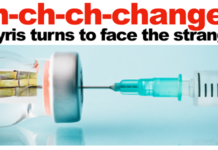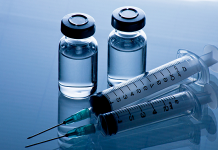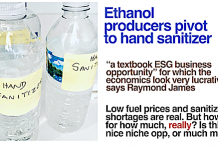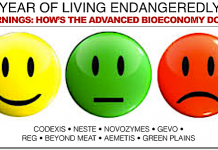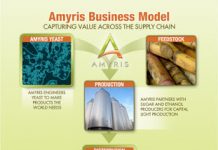Jim Lane
A first-to-market leader in bio-succinic acid comes to the public markets with its IPO.
Can BioAmber translate a lead in succinic acid’s smallish market into leadership in a vast array of high-priced renewable chemicals?
Here’s our 10-minute version of the BioAmber IPO, with a translation of the risks into English.
In Minnesota, BioAmber has filed an S-1 registration statement for a proposed $150 million initial public offering. The number of shares to be offered in the proposed offering and the price range for the offering have not yet been determined. The lead book-running managers for the offering are Goldman, Sachs & Co. and Credit Suisse Securities (USA) LLC. The additional book-running manager is Barclays Capital. The co-managers are Stifel, Nicolaus & Company, Incorporated and Pacific Crest Securities LLC.
The company is currently ranked #143rd in the world in the 50 Hottest Companies in Bioenergy. The rankings recognize innovation and achievement in fuels and are based on votes from a panel of invited international selectors, and votes from Biofuels Digest subscribers.
BioAmber, which in the past year lost $12.41M while recording no revenues becomes the 13th company to file for an IPO in the industrial biotech boom, which began with a successful listing on the NASDAQ by Codexis (CDXS) in 2010. IPOs by Amyris (AMRS), Gevo (GEVO), Solazyme (SZYM), and KiOR (KIOR) have followed. In recent months, PetroAlgae (PALG.OB), Myriant, Ceres, Genomatica, Mascoma and Elevance Renewable Sciences and Fulcrum Bioenergy have also filed S-1 registrations for proposed IPOs. T
Here’s the S-1 registration, in a conveniently downsized 10-minute Digest version – with some commentary along the way as to what is driving value in the BioAmber model, opportunities for the intrepid investor, and some risks which we have translated from the ancient and original SEC into modern English.
Company Overview
From the S-1: “We are a next-generation chemicals company. Our proprietary technology platform combines industrial biotechnology, an innovative purification process and chemical catalysis to convert renewable feedstocks into chemicals that are cost-competitive replacements for petroleum-derived chemicals.
“We manufacture our bio-succinic acid in a facility using a commercial scale 350,000 liter fermenter in Pomacle, France…We have produced 487,000 pounds, or 221 metric tons, of bio-succinic acid at this facility…We believe we can produce bio-succinic acid that is cost-competitive with succinic acid produced from oil priced as low as $35 per barrel, based on management’s estimates of production costs at our planned facility in Sarnia, Ontario and an assumed corn price of $6.50 per bushel.
“We have secured funding to construct the initial phase of our next global-scale facility in Sarnia, Ontario and we intend to build and operate two additional facilities, one located in Thailand and the other located in either the United States or Brazil.
“We expect to begin recording revenue from commercial sales of our bio-succinic acid in the first quarter of 2012…We also intend to leverage our proprietary technology platform and expertise in the production of bio-succinic acid to target additional high value-added products, such as bio-BDO, PBS, de-icing solutions and plasticizers. In addition, we are also working to expand our product portfolio to additional building block chemicals, including adipic acid and caprolactam.
“Since our inception, we have raised an aggregate of $76.1 million from private placements of equity securities and convertible notes.”
The Technology
From the S-1: “Our proprietary technology platform combines industrial biotechnology, an innovative purification process and chemical catalysis to convert renewable feedstocks into chemicals that are cost-competitive replacements for petroleum-derived chemicals. The development of our current organism was originally funded by the DOE in the late 1990s, was further developed and scaled up, and optimized at the large-scale manufacturing facility in France.
“We believe our solution enables us to address multiple large chemical markets, including polyurethanes, plasticizers, personal care products, de-icing solutions, resins and coatings, food additives and lubricants, that are currently being served by petrochemicals.
3 Key Qualities
1. Cost-competitive, renewable chemical alternatives that offer equal or better performance;
2.. Using less feedstock per ton of output than most other sugar-based processes for biochemicals other than succinic acid; and
3. Significantly lower greenhouse gas emissions than the processes used to manufacture petroleum-based products by sequestering carbon dioxide in the process of producing bio-succinic acid.
The Market
From the S-1: “First, we intend to replace petroleum-based succinic acid in applications where it is currently in use, such as food additives, as well as expand into new applications, such as plasticizers, where bio-succinic acid has demonstrated superior performance or economics to incumbent petrochemicals.
“Second, we intend to convert bio-succinic acid to bio-BDO and THF, which are large volume chemical intermediates that are used to produce polyesters, plastics, spandex and other products.
“Third, we intend to use our bio-succinic acid in the production of PBS, which enables this polymer family to be partially renewable, and modified PBS, or mPBS, which provides these products with higher heat distortion temperature and improved strength.
“We believe that these three market opportunities for our bio-succinic acid platform provide us with access to a more than $10 billion market opportunity.”
Current applications for bio-succinic acid include:
Plasticizers. We believe the addressable market for plasticizers exceeds $1 billion.
Polyurethanes. We believe the addressable market for polyurethanes exceeds $1 billion.
Personal Care Products. We believe the addressable market for succinic acid and succinate esters in the personal care industry is approximately $500 million.
De-icing Solutions. We believe the addressable market for de-icing solutions exceeds $500 million.
Resins and Coatings. We believe the addressable market for resins and coatings exceeds $500 million.
Food Additives. We believe the addressable market for food additives is approximately $200 million.
Lubricants. We believe the addressable market for lubricants is approximately $100 million.
C6 Building Block C
hemicals
From the S-1: “We expect to use our flexible technology platform, including our partnership with Celexion, to expand our product base to C6 building block chemicals, starting with bio-adipic acid, by leveraging our extensive experience developing, producing and marketing bio-succinic acid. We also plan to produce biobased caprolactam and biobased hexamethylenediamine (HMDA). We believe the addressable market for adipic acid is approximately $6.5 billion. We believe the addressable market for caprolactam is approximately $14.5 billion. We believe the addressable market for HMDA exceeds $3 billion.”
The Strategy
Rapidly Expand Our Global Manufacturing Capacity.
Target the Large and Established BDO Market.
Develop Next-Generation Succinic-Derived Products.
Continue to Reduce the Cost of Our Products.
Expand Product Platform to Additional Building Block Chemicals.
The Commercialization Plan
From the S-1: “In order to support our growth, we plan to rapidly expand our manufacturing capacity beyond the current production at the Pomacle, France facility. We have entered into a joint venture with Mitsui to finance, build and operate a manufacturing facility in Sarnia, Ontario through our Bluewater Biochemicals, Inc. subsidiary in which we own a 70% equity interest and Mitsui owns the remaining 30%. The joint venture agreement also establishes our intent to build and operate two additional facilities with Mitsui, one located in Thailand and the other located in either the United States or Brazil.
“For future facilities, we expect to enter into agreements with partners on terms similar to those in our agreement with Mitsui and we intend to partially finance these facilities with debt. We expect to use available cash and the proceeds of this offering to fund our initial facilities, as well as our commercial expansion and product development efforts. For additional future facilities, we currently expect to fund the construction of these facilities using internal cash flow and project financing.”
The Risks, Translated from SEC-speak
Among the lowlights of reading S-1 registrations are the endless pages of risk disclosures (in BioAmber’s case, 28 pages of them) couched in an alloy of SECspeak and legalese. We offer these excerpts from the original S-1, and a translation into English, prepared by our Digest lexicologists.
In SECspeak: ”We have a limited operating history, a history of losses, anticipate continuing to incur losses for a period of time, and may never achieve or sustain profitability.”
In English: “Our investors have grown tired of losing their money, and have encouraged this IPO in the hope of losing some of yours.”
In SECspeak: “We may not obtain the additional financing we need in order to grow our business, develop or enhance our products or respond to competitive pressures.”
In English: “Now that we are losing some of your money, you might run out.”
In SECspeak: “The funding, construction and operation of our future facilities involve significant risks, which may prevent us from executing our expansion strategy.”
In English: “The Titanic is, after all, practically unsinkable.”
In SECspeak: “Our prior success in developing bio-succinic acid may not be indicative of our ability to leverage our bio-succinic acid technology to develop and commercialize derivatives of bio-succinic acid and other bio-based building block chemicals.”
In English: “To make the real bucks, we got to make all that other stuff that we haven’t actually practiced making yet.”
In SECspeak: “Demand for our bio-succinic acid, bio-BDO and other bio-succinic acid derivatives may take longer to develop or become more costly to produce than we anticipate, and technological innovations in our industry may allow our competitors to produce them at a lower cost, which may reduce demand for our products.”
In English: “We may be kidding about everything in this IPO, except the bits about how tough this market is to crack.”
In SECspeak: “We are dependent on our relationships with strategic partners, licensors, collaborators and other third parties for research and development, the funding, construction and operation of our manufacturing facilities and the commercialization of our products and our failure to manage these relationships could delay or prevent us from developing and commercializing our products.”
In English: “Help, I need somebody, / Help, not just anybody, / Help, you know I need someone, / Help!”
In SECspeak: “Our inability to adequately protect and enforce our intellectual property, or to prevent the operation of our business from infringing the intellectual property of others, may make it difficult or cost prohibitive to carry on our business as currently planned.”
In English: “We bring knives to what may well become a gunfight.”
BioAmber as it sees itself: 7 Competitive Strengths
Proprietary Technology Platform that Addresses a Large Market Opportunity. We own or have exclusive rights to specific microorganisms, chemical catalysis technology and a unique, scalable and flexible purification process.
Selling Commercial Product Today. We have sold bio-succinic acid to 12 customers in 2011. We believe we are the first and only company selling bio-succinic acid products in commercial quantities.
Proven Cost-Competitive Economics at Large Scale. We expect to produce bio-succinic acid at our planned facility in Sarnia, Ontario that is cost-competitive with succinic acid produced from oil priced as low as $35 per barrel.
Limited Exposure to the Availability and Price of Sugar. Our process requires less sugar than most other renewable products because 25% of the carbon in our biosuccinic acid originates from carbon dioxide.
Established, Diverse Customer Base. We have entered into supply agreements for the sale of over 84,000 metric tons of bio-succinic acid and its derivatives over the next five years.
Third-Party Commitments for Global Manufacturing Expansion. We have signed an agreement with Mitsui to jointly build a facility in Sarnia, Ontario…[and our] agreement with Mitsui contemplates the construction and operation of two additional facilities.
Experienced Management Team with Strong Track Record. Our management team consists of experienced professionals, possessing on average over 25 years of relevant experience in scaling up, manufacturing and commercializing chemicals, at Cargill, DuPont, INVISTA, Dow Corning, GE, Royal DSM and Genencor.
Financing to date
From the S-1: “We issued 11,659 shares of common stock, 33,655 shares of preferred stock and warrants to purchase 18,769 shares of common stock at exercise prices between $37.52 and $100.00.
“On February 6, 2009, we issued secured debentures and warrants for 18,760 shares of common stock at a per share cost of $50.00 for aggregate consideration of $938,000.
“On June 22, 2009, we issued in a private placement a secured convertible promissory note and warrants for 5,970 shares of common stock to FCPR Sofinnova Capital VI for gross proceeds of $4 million.
“On October 22, 2009, we issued in a private placement an aggregate of 59,702 shares of common stock at a per share cost of $201.00 for aggregate consideration of $12 million.
“On February 1, 2010, we issued 5,000 shares of common stock at a price of $201.00 per share to Shanghai KEQI and Sinoven LLC.
“On November 23, 2010, we issued secured convertible promissory notes in a private placement for gross proceeds of $4 million. The promissory notes were converted into 10,833 shares of common stock and warrants to purchase 2,707 shares of common stock at an exercise price of $369.14 with a ten-year term.
“On April 15, 2011, we issued in a private placement an aggregate of 121,904 shares of common stock and warrants for 2,707 shares of common stock at a per share cost of $369.14 for aggregate consideration of $44,999,643.”
“On November 4, 2011, we issued in a private placement an aggregate of 20,061 shares of common stock at a per share cost of $997.00 for aggregate consideration of $20 million to Naxamber S.A., FCPR Sofinnova Capital VI, Mitsui & Co., Ltd. and Clifton Equities Inc.”
The bottom line
Well, it really comes down to this. There isn’t much of a market in succinic acid. About 40,000 metric tons and $300 million. About the capacity of a standard ethanol plant – one. So, you have to take it, on essentially BioAmber’s say-so, that they can use their low-cost succinic as a base from which to chase everyone’s else’s high-priced other stuff.
On the side of belief, there’s a range of management talent and expertise at BioAmber that Wyatt Earp would have been proud to lean on at the OK Corral. Plus, you have the say-so of Mitsui, a Japanese trading house of long lineage and a distinct “no dummies” hiring policy. And, there’s a nice first-mover advantage.
But then there are the risks. For one, that Verdezyne might wrap up bio-based adipic acid before BioAmber gets there, as Genomatica might wrap up BDO. The risk that BioAmber might not get to C6 building blocks as fast or cost effectively as they hope.
Outside of the C6 platforms, there’s $3.8 billion in addressable markets cited in the S-1. Figure 20 percent for the bio-based products in the near-term, that’s around $700 million. How much of that can BioAmber lock down in the near-ish term to provide meaningful cash flow to finance further expansion, and how much do they need to lock down to provide returns commensurate with a $150 million cash raise in the IPO?
So, it’s a bet – on a pre-revenue company with a hot technology and a meaningful market – if it can get there. Like many IPOs in this space this past year, it’s a financing event for the company’s expansion, rather than a liquidity event for the current investors. The current investors – well, they’d like to spread the risk by broadening the investor base before the company pushes through to commercial scale. It’s an oft-told tale – nothing daunting in that, per se.
Like a first-mover advantage in succinct acid, one that may translate into a lead in some of the biggest markets that will come by in renewable chemicals? Here’s the train for you.
If the risks are high, the rewards will be high for the daring investor who throughly vets the opportunities in the market, as well as the aptitude of the magic bug for all the work ahead that BioAmber has scheduled it to do.
The complete S-1 registration statement.
All 200-or-so pages in all their glory. The complete S-1 registration statement is here.
Jim Lane is editor and publisher of Biofuels Digest.

